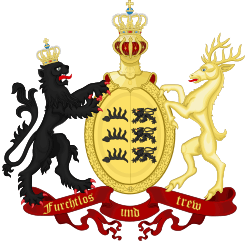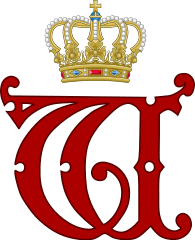William II of Württemberg
William II (German: Wilhelm II; 25 February 1848 – 2 October 1921) was the last King of Württemberg. He ruled from 6 October 1891 until the abolition of the kingdom on 30 November 1918.
| William II | |||||
|---|---|---|---|---|---|
.jpg) | |||||
| King of Württemberg | |||||
| Reign | 6 October 1891 – 30 November 1918 | ||||
| Predecessor | Charles I | ||||
| Successor | Monarchy abolished | ||||
| Born | 25 February 1848 Stuttgart, Kingdom of Württemberg | ||||
| Died | 2 October 1921 (aged 73) Bebenhausen, Württemberg, Weimar Republic | ||||
| Spouse | Marie of Waldeck and Pyrmont Charlotte of Schaumburg-Lippe | ||||
| Issue | Pauline, Princess of Wied Prince Ulrich | ||||
| |||||
| House | Württemberg | ||||
| Father | Prince Frederick of Württemberg | ||||
| Mother | Princess Catherine of Württemberg | ||||
| Religion | Lutheran | ||||
Early years
William was born the son of Prince Frederick of Württemberg (1808–1870) by his wife Princess Catherine Frederica of Württemberg (1821–1898), herself the daughter of King William I of Württemberg (1781–1864). His parents were first cousins, being the children of two brothers, and William was their only child.
William's growing years coincided with a progressive dimininution of Württemberg's sovereignty and international presence, concomitant with the process of German unification. In 1870, Württemberg took the side of Prussia in the Franco-German War. In 1871, Württemberg became a state of the German Reich, a significant limitation on its sovereignty.
King of Württemberg
William's father died in 1870, but his mother lived to see him seated on the throne of Württemberg. In 1891, William succeeded his childless maternal uncle, King Charles I (1823–1891) and became King of Württemberg. This was not, as it may seem, a departure from the Salic law which governed succession in the German states; his claim to the throne came because he was the nearest agnatic heir of his maternal uncle, as the senior male-line descendant of Frederick I of Württemberg through his younger son Prince Paul.
King William became a Generalfeldmarschall during World War I. In 1918, he was deposed from the throne along with the other German rulers. King William finally abdicated on 30 November 1918,[1] ending over 800 years of Württemberg rule. He died in 1921 at Bebenhausen.
Personality and interests
Considered to be a popular monarch, William had the habit of walking his two dogs in public parks in Stuttgart without being attended by bodyguards or the like. During these excursions, he would often be greeted by his subjects with a simple Herr König ("Mister King").
Despite living in a landlocked kingdom, William II was a yachting enthusiast. The king was instrumental in the establishment of the Württembergischer Yacht Club (formerly "Königlich Württembergischer Yacht-Club" or Royal Yacht Club of Württemberg) in 1911 on Lake Constance.
Marriages and children
On 15 February 1877 at Arolsen he married Princess Marie of Waldeck and Pyrmont (1857–1882). They had three children:
- Princess Pauline of Württemberg (19 December 1877 – 7 May 1965); married in 1898 William Frederick, Prince of Wied (1872–1945), and had issue.
- Prince Ulrich of Württemberg (28 July 1880 – 28 December 1880), died in infancy
- A stillborn daughter (24 April 1882)
Marie died on 30 April 1882 in Stuttgart, from complications resulting from the birth of their third child. William, already depressed by the death of his only son, is said never to have recovered from this blow.
Nevertheless, he was King and it was his duty to secure the succession. On 8 April 1886, at Bückeburg, he married Princess Charlotte of Schaumburg-Lippe (1864–1946). They had no children.
Succession
With William II's death in 1921 without male issue, the royal branch of the House of Württemberg became extinct and the headship of the house devolved to Albrecht, Duke of Württemberg head of the Roman Catholic cadet branch of the dynasty which ruled the Kingdom of Württemberg.
Titles, styles, honours and arms
Titles and styles
- 25 February 1848 – 25 June 1864: His Royal Highness Prince William of Württemberg
- 25 June 1864 – 6 October 1891: His Royal Highness The Crown Prince of Württemberg
- 6 October 1891 – 30 November 1918: His Majesty The King of Württemberg
- 30 November 1918 – 2 October 1921: His Majesty the former King of Württemberg
Honours
- German awards


.svg.png)
.svg.png)
- Order of St. Hubert, Knight, 1877[4][5]
- Military Order of Max Joseph, Grand Cross

.svg.png)
.svg.png)
.svg.png)
.svg.png)
- Order of the Black Eagle, Knight[4]
- Johanniter Order, Knight of Honour[4]
- Pour le Mérite
.svg.png)
.svg.png)
- Order of the Rue Crown, Knight[4]
- Military Order of St. Henry, Grand Cross
- Foreign awards
.svg.png)
- Order of St. Stephen of Hungary, Grand Cross, 1886[9]
- Military Merit Cross, 1st Class
_crowned.svg.png)
.svg.png)


Arms
 Royal Monogram of King Wilhelm II of Württemberg |
 Coat of Arms of the Kingdom of Württemberg, 1817 |
 Royal Monogram of King Wilhelm II of Württemberg, Variant |
Ancestry
Three of William's four grandparents were of the House of Württemberg, an example of Royal intermarriage.
| Ancestors of William II of Württemberg |
|---|
See also
- Rulers of Württemberg
References
| Wikimedia Commons has media related to William II of Württemberg. |
- Abdication text (in German)
- Hof- und Staats-Handbuch für des Herzogtum Anhalt (1894), "Herzoglicher Haus-Orden Albrecht des Bären" p. 17
- Hof- und Staats-Handbuch des Großherzogtum Baden (1910), "Großherzogliche Orden" p. 39
- Justus Perthes, Almanach de Gotha (1921) p. 104
- Hof- und Staats-Handbuch des Königreichs Bayern (1906), "Königliche Orden" p. 7
- Hof- und Staatshandbuch des Herzogtums Braunschweig für 1905. Braunschweig 1905. Meyer. p. 11
- Staatshandbücher für das Herzogtum Sachsen-Coburg und Gotha (1884), "Herzogliche Sachsen-Ernestinischer Hausorden" p. 32
- Staatshandbuch für das Großherzogtum Sachsen / Sachsen-Weimar-Eisenach (1900), "Großherzogliche Hausorden" p. 16
- "A Szent István Rend tagjai" Archived 22 December 2010 at the Wayback Machine
- Boettger, T. F. "Chevaliers de la Toisón d'Or - Knights of the Golden Fleece". La Confrérie Amicale. Retrieved 25 June 2019.
- "Sveriges statskalender (1921) p. 369" (in Swedish). Retrieved 2018-01-06 – via runeberg.org.
- Shaw, Wm. A. (1906) The Knights of England, I, London, p. 72
External links
William II of Württemberg Born: 25 February 1848 Died: 2 October 1921 | ||
| Regnal titles | ||
|---|---|---|
| Preceded by Charles I |
King of Württemberg 1891–1918 |
Monarchy abolished German Revolution |
| Titles in pretence | ||
| Loss of title |
— TITULAR — King of Württemberg 1918–1921 Reason for succession failure: Kingdom abolished in 1918 |
Succeeded by Duke Albrecht |